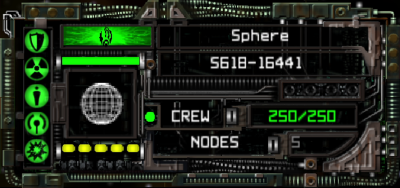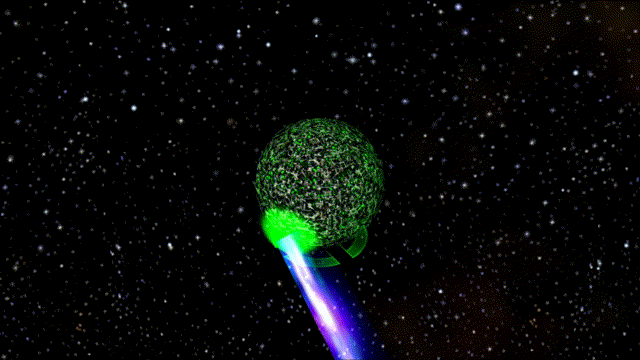Inhaltsverzeichnis
Armada 1 Sub-Systems
In the game Star Trek: Armada each unit can have up to five sub-systems from the following list:
| System | |
|---|---|
| | engines |
| | life support |
| | sensors |
| | shield generators |
| | weapons |
Some are not necessary at all for a unit, e.g. stations will not have engines. Life support is only necessary, when a unit actually does have crew. So un-manned defense platforms will not have it, as they don't need it. The only generally used sub-system are the sensors, as a blind unit would be kind of strange.
In-Game Depiction and Meaning
All sub-systems are displayed in this panel (left hand side):

The indicator symbols can convey different states of each sub-system:
| State | |
|---|---|
| | In this state, all indicators are green, all sub-systems are working properly. If a sub-system has enough hit points but some of them are already gone, you may encounter a pie-chart like change in color, similar to the example of the damaged systems. In the given example, all systems are OK. |
| | This example shows the engines sub-system being deactivated. Deactivation means, the system will come back online in a few moments, depending on whether the cause for the deactivation (Special Weapons or Nebula effects) is mitigated. Certain special weapons can override this, e.g. the Federation Repair Team. In such a case, the colors can be mixed green stable and yellow flashing at the same time for a specific system. |
| | This example shows a state where shield generators, life support and weapons are damaged. The red color indicates the amount of remaining system damage. These systems got destroyed and are in need of restoration/repairs. Until these systems are repaired 100%, they will remain offline. Either repair the unit in a yard, or give the crew time to do it on their own. Partially repaired systems are depicted by a pie-chart shape. In the example you can see, that the life support system is repaired to ca. 20% while shield generators and weapons are roughly at 1/6. Repairs cannot happen on their own, if a unit requires crew while not having any. |
| | This example shows the sub systems of a defense platform. The grayed out engines and life support systems are simply missing, as they are not needed for a crewless stationary unit, such as a defense station. |
Engines
 The engines system allows a unit to move and stir. If it is not present, gets deactivated or damaged, the unit will not have the capability of movement or course alteration. Stations never have engines. Ships always have engines. Ships with deactivated or damaged engines can be towed by a Tractor Beam.
The engines system allows a unit to move and stir. If it is not present, gets deactivated or damaged, the unit will not have the capability of movement or course alteration. Stations never have engines. Ships always have engines. Ships with deactivated or damaged engines can be towed by a Tractor Beam.
Engines don't always give their unit the same speed. The speed is defined for each ship by itself (although may be inherited from another definition file). The most common speed values are 50 for Casters, Freighters and Constructors, 100 for Destroyers and Scouts, and 80 for the rest. Gravity Mines can slow down any ship considerably, depending on how many are attached to the ship. All Nebulae slow down ships passing through them to a certain degree.
Important: If the engines get deactivated or damaged, a nearby Black Hole may take effect and drag the ship towards it. If the ship touches the black hole's center, it gets instantly destroyed. Also inertia is still effective. So a ship moving at full engine speed may be thrown away at considerable velocity, when its engines get deactivated all of a sudden.
The Ferengi will consider any ship, that has lost its engines a target for stealing. By default a ship that regains its engines should drop from a possible already attached tractor beam. But the game seems to have a bug, so that this happens not always.
Deactivated or damaged engines have their own animation on a ship's model, a redly-orange flare:
Life Support
 This system is only required, when a unit actually has crew. In the stock game there are three types of unmanned stations: Sensor Stations, Pulse Defense Stations and Torpedo Defense Stations. The rest have crew and all stock ships also have crew. Therefore the vast majority of units require life support. If life support is not present, deactivated or damaged, the crew gets reduced over time, similar to being inside a Radioactive Nebula. The crew drain will continue, until either the ship is emptied from crew or the life support system is restored. The more crew is still remaining, the faster the crew drain is going. That makes units with big amounts of crew, such as the Cube or Starbases very vulnerable to the effects of life support damage or deactivation during the first few seconds.
This system is only required, when a unit actually has crew. In the stock game there are three types of unmanned stations: Sensor Stations, Pulse Defense Stations and Torpedo Defense Stations. The rest have crew and all stock ships also have crew. Therefore the vast majority of units require life support. If life support is not present, deactivated or damaged, the crew gets reduced over time, similar to being inside a Radioactive Nebula. The crew drain will continue, until either the ship is emptied from crew or the life support system is restored. The more crew is still remaining, the faster the crew drain is going. That makes units with big amounts of crew, such as the Cube or Starbases very vulnerable to the effects of life support damage or deactivation during the first few seconds.
Deactivated or damaged life support systems do have an animation indicator on unit models a bluish-white flare:
Sensors
 The sensors give a unit the ability to see its environment. There are basically two kinds of states for sensors: If the sensors are present and active, the maximum sensor range is used. See Radii on more details regarding the maximum scanning range. If the sensors are deactivated or damaged, they still allow the unit to see, but in a much smaller range. Deactivation can happen due to the effects of a Sensor Jammer or by being in a Mutara Nebula. All units of the stock game have sensors.
The sensors give a unit the ability to see its environment. There are basically two kinds of states for sensors: If the sensors are present and active, the maximum sensor range is used. See Radii on more details regarding the maximum scanning range. If the sensors are deactivated or damaged, they still allow the unit to see, but in a much smaller range. Deactivation can happen due to the effects of a Sensor Jammer or by being in a Mutara Nebula. All units of the stock game have sensors.
Important: Sensors alone may not be sufficient so see everything of importance. The Detector Mechanics may make a unit invisible to ordinary sensors. Without the Tachyon Detection Grid cloaked units will not be visible, regardless of sensor range.
Shield Generators
 Basically, all units have two kinds of hit points (health). Some damage that can be absorbed by hardpoints, such as the here described sub-systems, which kind of make up the unit's substance. And on the other hand, there is the (usually) much bigger amount of protecting hit points, in form of the shields. Every stock unit has shields, being provided and replenished by the shield generator. If the shield generators fail, the unit loses the protection of the shields, meaning all damage inflicted will be applied directly onto the ship until shields are restored. Cerulean Nebulae and Mutara Nebulae as well as the Shield Disruptor deactivate the shield generators.
Basically, all units have two kinds of hit points (health). Some damage that can be absorbed by hardpoints, such as the here described sub-systems, which kind of make up the unit's substance. And on the other hand, there is the (usually) much bigger amount of protecting hit points, in form of the shields. Every stock unit has shields, being provided and replenished by the shield generator. If the shield generators fail, the unit loses the protection of the shields, meaning all damage inflicted will be applied directly onto the ship until shields are restored. Cerulean Nebulae and Mutara Nebulae as well as the Shield Disruptor deactivate the shield generators.
In order to have shields, usually (but not always) you need the shield generator. Units without shield generator may technically start out with some shield energy, but it will not be replenished. If the shield generator gets damaged, the shields will be gone in an instant (not restored to their original value upon repair completion), leaving the unit vulnerable for a longer period of time. If the shield generator gets only deactivated, the shields will be dropped for the moment, but the shield energy will be restored, once the shield generator is returning to normal operations.
This already shows, that there is a difference between having shield energy and having a working shield generator. The mechanics are even a bit more complex, once restoring mechanisms are taken into consideration. If the shield generators of a unit are currently down, but the shield energy is restored via Energy Shield Converter, then the unit may have no shield generators at the moment, but still have shield energy (again), protecting the substance of the ship. On the other hand, a deactivated shield generator may also be made working again by applying the Federation Repair Team. Once done, the shield generator indicator is still flashing as if deactivated, but they actually do work again. This is different to applying it to an actually damaged shield generator, which will also work properly again, but the damage is gone, too.
While a deactivated shield generator is indicated by dropped shields, the unit's model's animation may not show it at all, if there are remaining shields. But usually damaged or deactivated shields look like rotating bluish bands:
Weapons
 The weapons sub-system decides whether a unit does have any kind of working weapons. A unit without working weapons system does not have special weapons capabilities, nor does it have working ordinary weapons. Only exception seems to be the passive ability of the Tachyon Detection Grid of the Sensor Stations. These stations do not have a weapons system, but the Tachyon Detection Grid is still working (once researched).
The weapons sub-system decides whether a unit does have any kind of working weapons. A unit without working weapons system does not have special weapons capabilities, nor does it have working ordinary weapons. Only exception seems to be the passive ability of the Tachyon Detection Grid of the Sensor Stations. These stations do not have a weapons system, but the Tachyon Detection Grid is still working (once researched).
Weapons can be deactivated by Special Weapons as well as Cerulean Nebulae.


